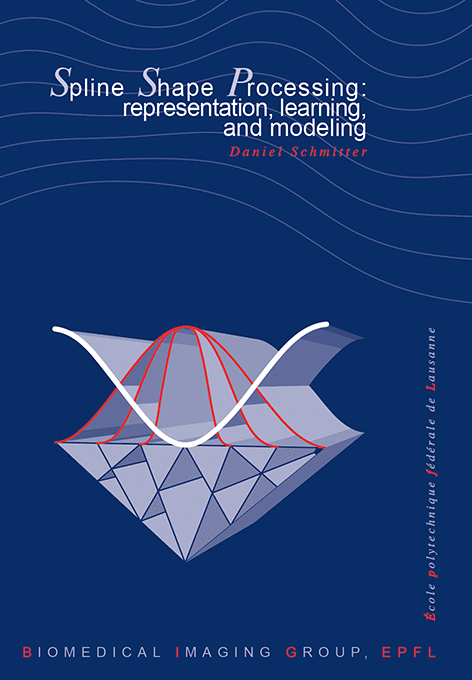Spline Shape Processing: Representation, Learning, and Modeling
D. Schmitter
École polytechnique fédérale de Lausanne, EPFL Thesis no. 8174 (2017), 241 p., November 27, 2017.
In this thesis, we present a novel generic and unifying framework for data-adaptive shape modeling. Our work is motivated by the raising need for powerful geometric modeling kernels that are required for shape characterization in biomedical imaging. The ongoing development of faster and more precise hardware in biomedicine creates new demands regarding the characterization, processing, and analysis of shapes in medical and biological data such as MRI, CT or microscopy. We develop a novel mathematical framework to construct a geometric kernel that is capable to represent deformable shapes in the contexts of segmentation, visualization, and deformation, while also enabling user-interaction, fast optimization as well as the construction of shape dictionaries for shape encoding. Our approach relies on spline-based concepts for shape representation in computer graphics combined with spline-theoretical fundamentals from signal and image processing.
This thesis is organized in two main parts. In the first part, our main contribution is the development of a novel generic framework to encode shapes, learn dictionaries and construct shape projectors onto functional vector spaces defined by spline shapes. Our construction is formulated in the continuous domain and we propose solutions based on L2-methods as well as sparsity-promoting ℓ1-based methods. Our contribution is generic in the sense that it is applicable to any spline-based generator that forms a Riesz Basis. We apply our solution to classify shapes in medical ultrasound images, to learn dictionaries of brain structures and to construct robust shape priors for segmentation algorithms.
In the second part of this thesis, our contribution is a novel data-adaptive framework to construct deformable shapes with different kinds of topology that are used in a broad spectrum of applications such as the semi-automatic segmentation of biomedical structures, user-interactive shape modeling, shape deformation and morphing, shape reconstruction from samples as well as the visualization and animation of shapes. We construct novel families of spline-generators that facilitate intuitive user-interaction, shape modeling, and shape characterization, and we provide specific examples and validations of the use of our framework in practice.
The two parts of this thesis together build a unifying theory for the construction of a novel flexible geometric modeling kernel with a wide range of use and applications as we illustrate throughout this thesis with a vast amount of experiments.

@PHDTHESIS(http://bigwww.epfl.ch/publications/schmitter1705.html,
AUTHOR="Schmitter, D.",
TITLE="Spline Shape Processing: {R}epresentation, Learning, and
Modeling",
SCHOOL="{\'{E}}cole polytechnique f{\'{e}}d{\'{e}}rale de {L}ausanne
({EPFL})",
YEAR="2017",
type="{EPFL} Thesis no.\ 8174 (2017), 241 p.",
address="",
month="November 27,",
note="")